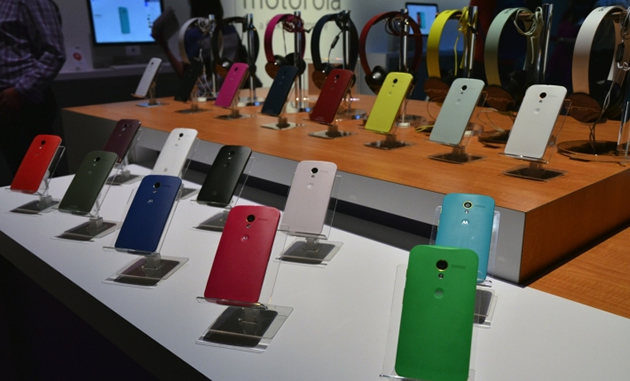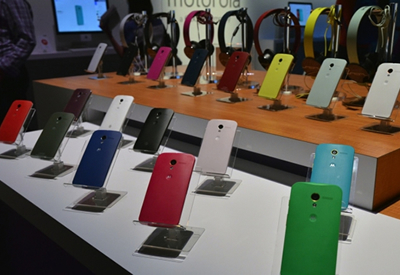 We saw it leaked weeks before it was announced — with even Google Chairman Eric Schmidt showing it off at a conference — but now the much hyped, mid-range Moto X smartphone is here. Google-owned Motorola revealed the Moto X today at a launch event in New York, revealing a briefcase full of Moto X phones each in one of the 18 available backplate colors.
We saw it leaked weeks before it was announced — with even Google Chairman Eric Schmidt showing it off at a conference — but now the much hyped, mid-range Moto X smartphone is here. Google-owned Motorola revealed the Moto X today at a launch event in New York, revealing a briefcase full of Moto X phones each in one of the 18 available backplate colors.
The back of the Moto X is dressed in Motorola’s signature textured Kevlar material, and besides choosing from among the 18 backplate cover colors, you can choose between a black or white front panel, and from seven options for the detail color on the side-mounted buttons and rear camera lens ring. You can also opt to engrave the back of your phone.
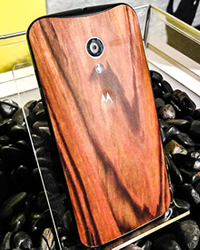 These choices — along with a choice of 16GB or 32GB of storage — add up to a total of 504 potential customization options. You pick the colors and options you want online, using a tool called Moto Maker. You can also choose from color-matched accessories like Otter Box cases, headphones, and arm bands. Motorola says that the high number of customizations are possible to US customers because the phone is the first smartphone manufactured in the US, aside from some of its internal components. The customized phones are assembled by some 2,000 workers at plant in Fort Worth, Texas, and can be shipped to US customers within four days.
These choices — along with a choice of 16GB or 32GB of storage — add up to a total of 504 potential customization options. You pick the colors and options you want online, using a tool called Moto Maker. You can also choose from color-matched accessories like Otter Box cases, headphones, and arm bands. Motorola says that the high number of customizations are possible to US customers because the phone is the first smartphone manufactured in the US, aside from some of its internal components. The customized phones are assembled by some 2,000 workers at plant in Fort Worth, Texas, and can be shipped to US customers within four days.
Motorola is unashamedly targeting the Moto X at mass and mid-market consumers, with a now-mid-range dual-core 1.7GHz Snapdragon S4 Pro processor, 2GB of RAM and 720p OLED display. Although the Moto X’s 4.7-inch screen is the same size as the displays on the Nexus 4 and HTC One, the Moto X is smaller than those phones, thanks to the very narrow bezels around the screen.
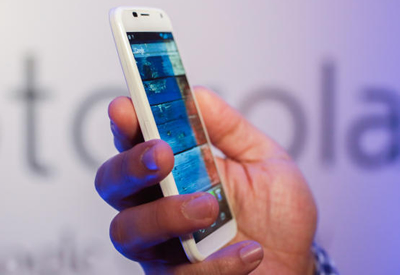 But the Moto X also packs some features that raise the bar for mid-range phones, like a rear 10-megapixel camera, front-facing 2.1-megapixel shooter, camera stabilization software, and support for LTE, NFC, Bluetooth 4.0+ EDR and 802.11ac Wi-Fi. The Moto X is one of the few phones that now come with a nano-SIM inside — a trend we’re likely to see much more of.
But the Moto X also packs some features that raise the bar for mid-range phones, like a rear 10-megapixel camera, front-facing 2.1-megapixel shooter, camera stabilization software, and support for LTE, NFC, Bluetooth 4.0+ EDR and 802.11ac Wi-Fi. The Moto X is one of the few phones that now come with a nano-SIM inside — a trend we’re likely to see much more of.
One of the standout unique features on the Moto X is what Motorola calls its “active display” that can show you your notifications on just part of the display, without the need to power on the phone, unlock, and swipe to go to the notification center. If you want to see more details about a notification, you swipe up. The phone refreshes your notifications regularly, says Motorola, and of course you turn off the notifications you don’t want to receive.
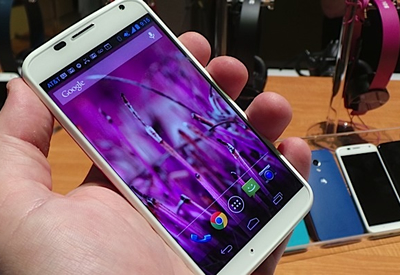 The Moto X’s X8 chip also supports the optional Google Now hands-free voice command feature. To call your friend Becky you’d just tell your phone “OK Google, now call Becky.” To stop a process, just say “cancel”. You can also tell the phone a destination, and it will read back the address and launch the navigation app. You can also ask for weather, sports stats, and alarms, among other things.
The Moto X’s X8 chip also supports the optional Google Now hands-free voice command feature. To call your friend Becky you’d just tell your phone “OK Google, now call Becky.” To stop a process, just say “cancel”. You can also tell the phone a destination, and it will read back the address and launch the navigation app. You can also ask for weather, sports stats, and alarms, among other things.
Google Now’s voice control system learns your voice through a training process where it listens to you repeat a phrase three times. Motorola claims that thanks to the X8 chip, the Moto X lasts for 24 hours with both touchless control and LTE mobile data activated.
Another unique feature to the Moto X is that by flicking your wrist, you can instantly launch the camera, even with the screen off. The camera will then auto-focus, auto-expose, and aut0-stabilize as needed, to reduce or eliminate blur. The camera software also lets you manually touch to focus, and set camera settings such as HDR (high dynamic range) or night shots. Motorola says that its camera technology will gather up to 75 per cent more light.
The Moto X will launch at the end of August first in the US on AT&T, Verizon, T-Mobile, Sprint, and US Cellular for $199, followed by other countries shortly-after, with the exception of the UK, where a different version will supposedly be offered. The customizable versions are initially exclusive to AT&T, but will supposedly be available to other carriers not long afterwards. Unlocked and developer versions will also be available, with pricing and availability to be announced. Motorola also announced a “Migrate Android” app to help you switch data between devices
The Moto X is Motorola’s fourth smartphone announced in just a few weeks. In late July Motorola unveiled the Droid Ultra, Droid Maxx, and Droid Mini for Verizon Wireless.
Here’s a roundup of some of the best Moto X hands-on videos and first, mostly glowing reviews:
CNET review: 4/5, a comfy Android with mass appeal
Engadget review: hits a sweet spot, but priced too high
Gizmodo review: the Android phone for everybody
SlashGear review: more than the sum of its parts
The Verge review: 8/10, redefining mid-range
Ubergizmo review: great user experience, but expensive
